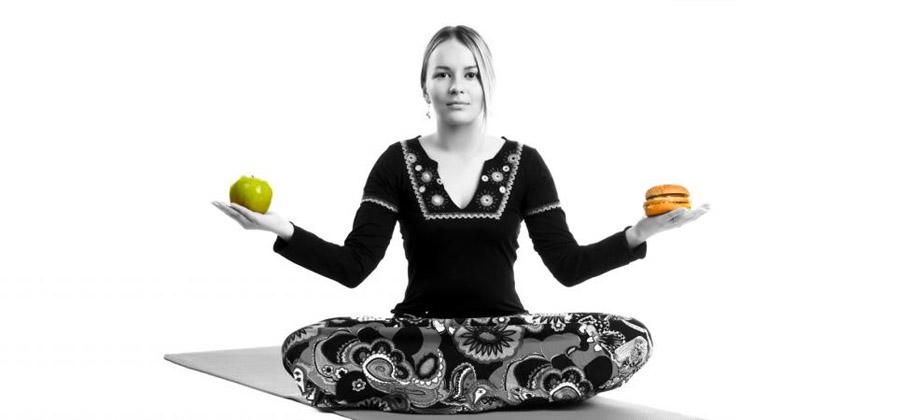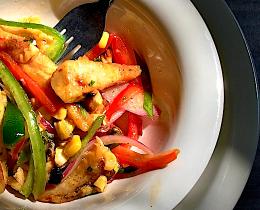Traditionally, yogis consumed sattvic foods that nourish the body and support a peaceful state, enabling the practitioner to function at maximum potential. Sattvic foods include nuts, fruits, vegetables, seeds, and legumes. Yogis were encouraged to stay away from rajasic foods that heat up the body, such as coffee and chocolate, and tamasic foods that are heavy, such as alcohol and preserved foods. Many yogis also included the yogic principle of ahimsa (nonviolence/noninjury) in their dietetic choices, by choosing to be vegan or vegetarian.
Today, many yogis wonder if they should adopt a vegan or vegetarian diet. Can a yogi eat sugar or drink alcohol? Does the practice of ahimsa demand that we be mindful of the politics and environmental and social impact of our food purchases? Do we need to eat organic? Does nonviolence mean that we come to the act of eating with a particular state of mind—that we eat mindfully? Does the practice itself make changes in the body that naturally lead to a more sattvic diet or that lead us to consider more closely the way we eat?
To help us explore these questions more deeply, we asked seven yoga teachers, “What’s a yogi to eat?”
Desirée Rumbaugh’s yoga practice has helped her look at food as a friend, rather than an enemy.
“The practice of yoga has made me more aware of every aspect of my body, including my digestive process. It only takes one forward bend after a big meal to spark that awareness. My practice taught me that eating lighter actually gave me more energy and strength.
When I was younger, and in the dance world, I had the typical obsession with being thin that drove me to almost anorexic behavior at times and overindulgence at other times. As a longtime yoga practitioner, I have learned to look at food as my friend, rather than as my enemy. My tastes have gradually changed so that I now crave lighter, more healthy food and it does not even require discipline or will power to turn down the less healthy choices in the world. I can now just look at food and feel whether or not it is a good thing for me to put in my body. I make my choices based on that feeling.”
Sham Rang Singh Khalsa says good food alone is not enough—it needs to be accompanied by good breathing and good living.
“Yoga and meditation practice can bring an understanding of the importance of digestion, in its smaller and larger sense. We can eat pure (sattvic) foods that are perfectly tailored for our individual constitution, yet still suffer in relation to food. Digestion, absorption, and elimination work much better with good food, but one still needs a strong digestive fire (agni).
We want to choose food that will bring in needed prana (life force), but also combine it with energy from good breathing and good living. Let us build physical digestion not just with digestive aids, but with the nurturance of our meditative discernment (buddhi) to foster right choices and right understanding. And let us receive food and all gifts from life with gratitude, that we may build a loving container for it all.”
Beryl Bender Birch became a “spontaneous vegetarian,” but believes that yoga doesn’t proselytize and that there are many truths.
“In l971, I was living in California and studying upa yoga (the yoga of vigilant watching), meditation, and philosophy with Munishree Chitrabhanu, a Jain monk who had just arrived in the United States. All Jains are vegetarian, because they espouse ahimsa, or nonviolence.
One day I went to this very upscale market in Hollywood and bought a porterhouse steak. I had virtually no money in those days, so this was a big deal. I got it home and made a major production out of grilling it. I sat down to eat it, and it tasted awful—like dead meat. I threw it out and that day I became a spontaneous vegetarian. I didn’t ‘try’ to stop eating meat. It just happened, not so much for health reasons, but for the ethical awareness brought on by my Jain studies.
Another important thing I learned from my teacher, Chitrabhanu, was the principle of anakantavada—the notion that truth and reality are perceived differently from diverse points of view, and that no single point of view is the complete truth. In other words, yoga doesn’t proselytize. It took me about 25 years to really get behind the practice of this principle, but once you ‘get’ it, you realize that the Vedantic principle of ‘one truth, many paths,’ is fundamental to true spiritual growth.”
John Douillard believes that yoga practice helps us to change the brain in a way that physiologically changes our relationship to eating.
“Yoga has a calming influence that allows the brain and all its incessant thinking to slow down and become more aware. Once we are more aware, we can make food choices based on our true nutritional needs, rather than the cravings the mind generates to get a quick fix. Ninety-five percent of the serotonin in the body is produced in the gut, and only five percent is in the brain at any given time. Using yoga as a tool to still the mind is actually calming the gut so that it can manufacture and deliver the neurotransmitters, like serotonin, that the brain needs to cope with stress. In the end, a less-stressed brain will make healthier food choices.”
David Life suggests “food” is just a name we give to other living beings (plant or animal) and “diet” is a contemplation of our consumption of that life.
“Diet, strictly as a yogic tool for enlightenment, is regarded as a field of tapas, or restriction. The traditional yogic restriction of diet is not guided by ideas of the health of one’s own physical body, but by ideas of ways to control appetite, needs, and negative impact on the world around us. A yogi simply eats to live rather than living to eat. A yogi traditionally begged for food and would never hoard food or even have a place to prepare food.
From the Ayurvedic point of view, food is used to balance the doshas, or aspects of the physical body. The Ayurvedic idea is to create a balance in the humors of the physical body, leading to health. Both Ayurveda and yoga stress the importance of vegetarianism.
My own approach to diet and food has been influenced by both of these traditional approaches, fused with a contemporary awareness of the need to extend compassion to all living beings, and ideas of nutrition and food.”
Sharon Gannon is a strong advocate for a vegan diet, saying a nonvegan diet violates more than a few yamas.
“The practice of yoga has provided support for my vegan diet. In the Yoga Sutra of Patanjali we find the yamas, five points of guidance for how we should relate to others, all of which support a compassionate vegan diet. Those directives are: ahimsa (non-violence), satya (truthfulness), asteya (nonstealing) brahmacharya (not to abuse others sexually), and aparigraha (greedlessness). Eating animal-based foods like meat, fish, eggs, and dairy products, goes against the yamas. How? Eating animals and animal products causes harm. It is based on lies, promotes stealing, involves sexual abuse, and is greedy.
To eat an animal you have to kill it; violence and harm are involved. Cows and other animals are enslaved and exploited for the milk, eggs, and babies they produce. We are told that it is a necessary evil to harm animals for our own health and survival—this is a lie perpetuated by the industries that make monetary profits from such death and abuse. Every time we eat meat, eggs, honey, or dairy products, we are stealing from those animals. Every animal raised for food is sexually abused by human beings—violently and callously raped. The raising of animals for food is also destroying our fragile ecosystem—polluting the water, air, and soil, and emptying our oceans. Our greed is causing the rest of the world to become compromised.”
Chelsea Roff eats for optimal energy to support her life rather than letting food run her life.
“The practice of yoga changed the way I related to food because it changed the way I related to my body. Very simply, practicing yoga made me more aware of what was happening inside my body—a process scientists call ‘interoception.’
Many of us have trained ourselves to ignore sensations like hunger and fullness because we’re afraid of our desire for food. Or we eat to anesthetize our feelings, in which case hunger and fullness signals get in the way. Yoga, in my experience, rebuilds the connective awareness between body and mind. When you're doing a twisting pose or a heart-opening backbend, it's nearly impossible not to experience the sensations in your belly. I think yoga strengthens the ‘internal awareness muscle,’ if you will, and thus makes us more aware of how what we eat impacts our vitality.
Many of us find that the longer we practice yoga, the more we begin to think differently about our food choices. How will what I eat for lunch today affect my digestion? Will eating breakfast give me more energy in the morning? Does my body need a certain type of food right now to function at its optimal level? For me, yoga made my relationship with food more functional. I began eating to support my life, rather than letting food run my life.”



